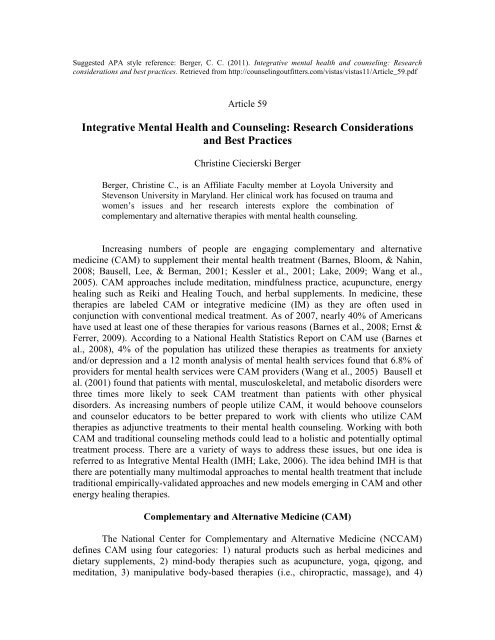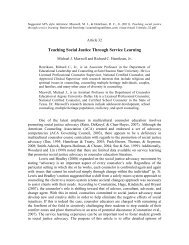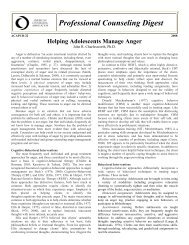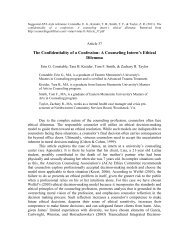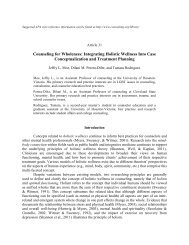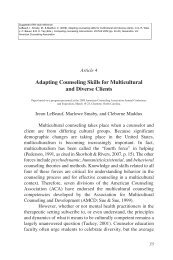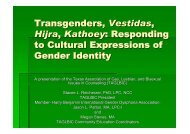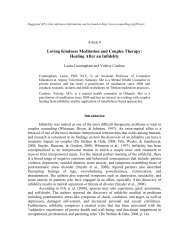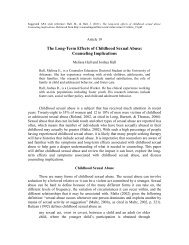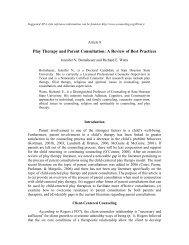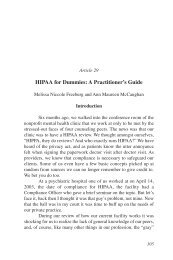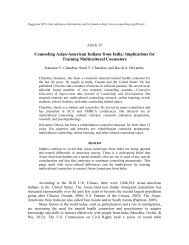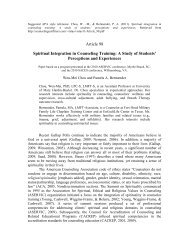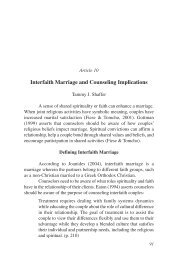Integrative Mental Health and Counseling - Counselingoutfitters.com
Integrative Mental Health and Counseling - Counselingoutfitters.com
Integrative Mental Health and Counseling - Counselingoutfitters.com
Create successful ePaper yourself
Turn your PDF publications into a flip-book with our unique Google optimized e-Paper software.
Ideas <strong>and</strong> Research You Can Use: VISTAS 2011levels <strong>and</strong> to serve many systems (Gale & Austin, 2003). <strong>Counseling</strong> aims to help clientsaddress their wounds <strong>and</strong> psychopathology with the hope of moving into optimal mentalwellness where clients may live more self-actualized lives (Sperry, 2005). At the sametime, but separately <strong>and</strong> under a different operational design, integrative therapies aim tohelp clients heal from the many wounds <strong>and</strong> traumas that occur in a human lifetime.However, neither counseling nor CAM has interacted intentionally with the other toaddress what each brings to the larger conversation on healing <strong>and</strong> wellness. In order tobetter underst<strong>and</strong> the impact of CAM it is important to review existing research <strong>and</strong>consider clinical applications.Research ReviewTo date, there are many studies being conducted using r<strong>and</strong>omized, controlled,double-blind designs which attempt to parse out true effects of CAM treatments fromplacebo effects to demonstrate the empirical validity of <strong>com</strong>plementary <strong>and</strong> alternativemedicine (Lake, 2006; NCCAM, 2010; Shah et al., 1999). Most studies have beenconducted in the fields of medicine <strong>and</strong> nursing but, as demonstrated, there areimplications for mental health <strong>and</strong> counseling. In general, the research has focused onchronic pain <strong>and</strong> other physical disorders but some studies have examined psychologicaldisorders such as depression <strong>and</strong> anxiety as mostly secondary out<strong>com</strong>es (NCCAM, 2010;Krisanaprakornkit, Krisanaprakornkit, Piyavhatkul, & Laopaiboon, 2006). This researchis broad, covering the NCCAM categories of nutrition, energy, <strong>and</strong> herbs, to name a few.There are a few studies directly linking the helping professions <strong>and</strong> CAM butcurrently the number is small <strong>and</strong> none have examined the relationship betweencounseling <strong>and</strong> CAM specifically. Caldwell, Winek, <strong>and</strong> Becvar (2006) <strong>and</strong> Becvar,Caldwell, <strong>and</strong> Winek (2006) explored the relationship of CAM to marriage <strong>and</strong> familytherapists (MFTs) both through a national survey <strong>and</strong> through qualitative interviews <strong>and</strong>found that MFTs are indeed encountering clients using CAM. However, they stated thatthe MFTs lacked education about the various therapies <strong>and</strong> determined that there was aneed for further education for both practitioners <strong>and</strong> clients so that these therapies can beproperly assessed for safety <strong>and</strong> efficacy.Some studies have looked at the use of acupuncture as an adjunctive treatment forsubstance abuse (Brumbaugh, 1993). There are a variety of reasons why substance abusecounselors have explored CAM but one important reason is treatment resistance with theclients. This area, if further explored, could add more weight to the continued researchlooking at the connection between CAM <strong>and</strong> counseling. Thus far, the counseling fieldhas not yet explored this issue in a generalized sense. One study by Collinge, Wentworth,<strong>and</strong> Sabo (2005) examined the <strong>com</strong>bination of psychotherapy <strong>and</strong> energy therapies onsuch disorders as PTSD <strong>and</strong> anxiety. They used a small mixed methods design which hadsome flaws, but they found that both types of treatment were favorable for the clients insearch of healing.Many individuals seek out CAM without necessarily consulting the research <strong>and</strong>evidence evaluation (Berman & Straus, 2004). This discrepancy will be discussed as ameans to guide clients toward best CAM practices to supplement their counseling if theywish. Attempting to do empirical, quantitative research on energy therapies is achallenge, mainly because there tend to be too many confounds <strong>and</strong> some past research4
Ideas <strong>and</strong> Research You Can Use: VISTAS 2011which followed quantitative models produced mixed results (Tan et al., 2007; Warber,Kile, & Gillespie, 2003). Healing Touch (HT) researchers Wardell <strong>and</strong> Weymouth (2004)conducted a meta-analysis on HT, an energy healing therapy, where they reviewed over30 studies with HT as an independent variable. They concluded that HT demonstratedclear trends in reducing stress, anxiety, <strong>and</strong> pain, <strong>and</strong> accelerated healing.For the purposes of focusing this discussion, I will use energy healing as aspecific example of the challenges to the research methodology. Most quantitative energyhealing studies have been found to be inconclusive <strong>and</strong> not generalizable (Astin,Harkness & Ernst, 2000; Berman & Straus, 2004; Vitale, 2007; Wardell & Weymouth,2004). Wardell <strong>and</strong> Weymouth (2004) suggested that this may be due to lack of criticalinformation in each examined study, which created problems with internal <strong>and</strong> externalvalidity. Wardell <strong>and</strong> Weymouth found that early research attempted to experimentallytest HT <strong>and</strong> Therapeutic Touch using the gold st<strong>and</strong>ard of r<strong>and</strong>omized, controlled trials<strong>and</strong> found intriguing trends, but statistical significance was weak <strong>and</strong> results were mixed.The authors concluded that these results were likely due to such research design problemsas unforeseen confounds <strong>and</strong> self-selected small samples. Warber et al. (2003) suggestst<strong>and</strong>ards for energy healing research as a means of aligning energy healing research withr<strong>and</strong>omized control trials. However, most of the research interest in these healingmodalities remained housed in the field of nursing so empirical information was notbeing translated to other fields such as medicine <strong>and</strong> counseling (Collinge et al., 2005).Tasaki et al. (2002) discuss the importance of <strong>com</strong>municating with physiciansregarding CAM <strong>and</strong> counseling. If this is not done, it can impede proper treatmentplanning. If counselors have clients who are receiving CAM treatments that may have animpact on their mental health counseling <strong>and</strong> are not aware of it, then this could have anundue negative impact on the counseling process.Placebo Effect <strong>and</strong> Energy HealingCriticism of the relevance <strong>and</strong> efficacy of some CAM methods such as energyhealing include discussion of the placebo effect. As it is st<strong>and</strong>ard scientific procedure totest treatment effects, it is critical to filter out placebo effects because the placebo effectis considered to cancel out the effect of the treatment. This means that any change isaccounted for by the beliefs of the subject, not an actual material effect of the treatment.One method to manage this challenge suggests asking patients receiving placebo controlsto intentionally expect to heal as a part of the research protocol (Luskin et al., 2000).However, there may be another way to consider the role of placebo in energyhealing research <strong>and</strong> that is to consider that the placebo effect might be considered ahelpful <strong>com</strong>ponent of treatment as an indicator of the potentially active <strong>and</strong> littleunderstood role of consciousness (Meehan, 1998; Weymouth, 2002). Robb (2006)explored the idea that the placebo may illustrate the body‟s ability to self-heal. Intraditional quantitative research, the goal is to try to isolate the treatment effect from allconfounds through r<strong>and</strong>omized, controlled studies. However, even in traditionalquantitative medical studies, at least one third of the effect can be attributed to theplacebo (Sternberg, 2000). However, healing research is inherently holistic <strong>and</strong> it maynot be possible to “isolate” variables as everything is conceptualized as whole <strong>and</strong>connected. The intention <strong>and</strong> consciousness of the HT/TT practitioner, rather than being5
Ideas <strong>and</strong> Research You Can Use: VISTAS 2011parsed out as a confound, may actually inform us that these phenomena (<strong>and</strong>consciousness specifically) may play a much larger role in health, healing, <strong>and</strong> wellnessthan was previously understood (Robb, 2006). In addition, Sternberg (2000) asserted thatif belief in healing <strong>and</strong> prayer help, although dismissed as placebo, perhaps the belief ispointing to actual physiological changes occurring in the body that have not yet beendetected or understood.<strong>Integrative</strong> <strong>Mental</strong> <strong>Health</strong> (IMH)The springboard for this paper emerged from a wellness <strong>and</strong> holistic model ofmental health, deemed by psychiatrist James Lake as <strong>Integrative</strong> <strong>Mental</strong> <strong>Health</strong> (Lake,2009). This approach addresses issues of wellness, spirituality, <strong>and</strong> cultural diversity. Itseeks to create a discussion regarding clinicians' experience with clients seeking IMH <strong>and</strong>how best to address these issues to provide optimal counseling to their clients. Lake‟sapproach involves a knowledge of the research on CAM treatments <strong>and</strong> assessing howbest to utilize these therapies to maximize treatment of mental disorders. It is a pragmatic<strong>and</strong> progressive approach in that it takes into consideration the energy system, the limitsof the research methodology, <strong>and</strong> the fact that there are real effects that may bechallenging to measure using the traditional scientific method (Lake, 2006). Lakeadvocates using the best CAM methods along with traditional therapy for particulardisorders, such as the herb kava, mindfulness practice, <strong>and</strong> cognitive therapy to treatgeneralized anxiety disorder (Lake, 2009). Beyond Lake‟s model, it seems that there areclinicians who have been utilizing these methods in various ways in recent years withoutneeding this label. However, it seems to be one of the first models to rigorously examinethe evidence <strong>and</strong> begin proposing mental health treatment protocols which organize thedisparate CAM treatments.The proposed model of IMH seems to provide many positive benefits in mentalhealth treatment <strong>and</strong> wellness promotion, as evidence is beginning to show that CAMtherapies help improve anxiety <strong>and</strong> depression (Kabat-Zinn et al., 1992; Miller, Fletcher,& Kabat-Zinn, 1995; Pilkington, 2010). This approach can be seen as a bridge tocounseling from integrative medicine as Lake writes from a psychiatric perspective.Since psychiatry, social work, psychology, <strong>and</strong> counseling all treat mental disorders, it isre<strong>com</strong>mended that counselors take up the call to engage this emerging paradigm sooner,rather than later. This seems to be a natural fit for the field of counseling as it st<strong>and</strong>s as aprogressive, advocating, holistic force in the large arena of mental health (Gale & Austin,2003; Ponton & Duba, 2009).Clinical Implications <strong>and</strong> ApplicationsAs increasing numbers of clients enter the counseling office with an adjunctiveCAM therapy, it will be<strong>com</strong>e imperative for counselors to engage with the research onthese therapies, their impact on mental health treatment, <strong>and</strong> how to decide tointentionally engage the integrative practitioner in a team treatment approach. It iscurrently hypothesized that team treatment may be indicated for <strong>com</strong>plex conditionswhich include mental health (Boon, Verhoef, O‟Hara, & Findlay, 2004). In addition, thismaterial could also be useful for faculty who teach counseling theory <strong>and</strong> practice or6
Ideas <strong>and</strong> Research You Can Use: VISTAS 2011clinical case conferences to better prepare them for this seemingly new chapter in theevolution of counseling <strong>and</strong> mental health.There appear to be three methods for counselors to use in considering an IMHmodel. The first, <strong>and</strong> most <strong>com</strong>mon, is to network with integrative therapy practitionersin their <strong>com</strong>munities to initiate a team treatment approach to mental health care. In thiscase, counselors will benefit by contacting integrative therapy practitioners in their<strong>com</strong>munities <strong>and</strong> making a professional connection to find out more about thepractitioners, who they are, their licenses <strong>and</strong> credentials, <strong>and</strong> their perspective on howtheir unique therapy interfaces with mental health issues as they arise in their practice.Another approach might be for counselors to include a category on their intakedocumentation to inquire if new clients are involved with any integrative therapies. If so,they could then inquire if the client would sign a release of information form for thecounselor to speak with the practitioner for a team treatment approach. It may not be thatthe treatment plan would change at all; it may be that one of the integrative therapies isaddressing somatic anxiety which would allow the counselor to focus on cognitive issuesor explore psychodynamic approaches. For example, in my doctoral dissertation Iinvestigated clients‟ use of both bereavement counseling <strong>and</strong> Healing Touch, an energytherapy, in their grief counseling. These are two distinct therapies that seemed to targetdifferent aspects of their personhood as they described their experiences to me ininterviews. Participants expressed satisfaction with the fact that both Healing Touch <strong>and</strong>counseling embraced various aspects of their identities, worldviews, <strong>and</strong> health. Forexample, a client could be seeing an acupuncturist to treat anxiety along with seeing acounselor to treat anxiety. In order to best treat the client, it would be optimal for bothpractitioners to be able to work collaboratively.Another method to start engaging in integrative mental health is to integrate<strong>com</strong>ponents of CAM therapies into practice: using diaphragmatic breathing, guidedimagery, <strong>and</strong> meditation practices such as mindfulness or Transcendental Meditation.Currently these have been utilized in PTSD treatment (Gehrman & Harb, 2010; Nappi,Drummond, Thorp & McQuaid, 2010) with promising results. In addition, people seekingCAM for physical health issues such as chronic pain management sometimes confrontemotions or mental health issues that may need to be addressed <strong>and</strong> this could promptengagement with counseling.Ethical ConsiderationsRegarding integrative mental health, it seems there may be two critical ethicalissues. The first is confidentiality <strong>and</strong> how it will be h<strong>and</strong>led in a team treatmentapproach. The second issue relates to the proper use of traditional counseling techniquesalong with CAM therapies in a counselor‟s private practice should the counselor seek tobe<strong>com</strong>e trained in a CAM therapy. There are increasing numbers of counselors who arepersonally or professionally interested in learning how to provide a CAM therapy(McGoldrick 2004) <strong>and</strong> it would be important to underst<strong>and</strong> the ethical implications ofexp<strong>and</strong>ing a counseling practice to include CAM therapies.If the counselor is a Reiki (h<strong>and</strong>s-on energy healing) practitioner, for example,<strong>and</strong> the client would be amenable to utilizing Reiki in the office, it would benefit theclient <strong>and</strong> the counselor to have a discussion about these two roles. This scenario would7
Ideas <strong>and</strong> Research You Can Use: VISTAS 2011likely warrant additional documentation regarding informed consent about Reiki, bodilyboundaries, <strong>and</strong> clients‟ <strong>com</strong>fort level with the counselor <strong>com</strong>ing physically closer tothem than counselors usually work. This is such a fledgling area that the discipline ofcounseling <strong>and</strong> state licensing boards would eventually need to discuss the dualrelationships in this example <strong>and</strong> whether they are inappropriate or may be <strong>com</strong>patible.Critique of <strong>Integrative</strong> <strong>Mental</strong> <strong>Health</strong>There are two primary critiques of integrative mental health. The first critique is:do we really need to engage these approaches? Because this is a new phenomenon inmental health it will likely take time for counselors to accept CAM therapies as possiblyinfluencing their work. Regarding this point, it may be best to assess one‟s currentcaseload for clients who may be involved in an integrative therapy. As Tasaki et al.(2002) indicate with CAM <strong>and</strong> medicine, poor <strong>com</strong>munications between clients <strong>and</strong> theirCAM practitioners <strong>and</strong> between clients <strong>and</strong> counselors regarding CAM use may impedetreatment. The second critique is: given the apparent tentative conclusions of theresearch, how much do we know <strong>and</strong> thus, how much can counselors actually do toengage with CAM therapies intentionally to foster <strong>Integrative</strong> <strong>Mental</strong> <strong>Health</strong>? On thispoint, the best way to proceed might be to continue to be<strong>com</strong>e educated about CAM <strong>and</strong>its effectiveness as measured in the literature. As methods demonstrate better efficacy formental health treatment, then it would be suggested that counselors seek out continuingeducation about the pertinent therapies to learn how to either incorporate them into theirclinical practices directly or at least know what to expect from the therapies with respectto their effects on client presentation <strong>and</strong> treatment goals.It seems that as CAM therapies be<strong>com</strong>e more popular <strong>and</strong> widely used,counselors should be as prepared as possible to underst<strong>and</strong> what these therapies are <strong>and</strong>how they function in their clients‟ lives. This approach may evolve into a new counselingtheory called integrative mental health. As research methods evolve, <strong>and</strong> as more clientsseek out adjunctive or replacement therapies in CAM, the field of counseling can onlyexp<strong>and</strong> <strong>and</strong> grow as the field embraces its call to holism <strong>and</strong> optimal mind-body-spiritwellness. Gale <strong>and</strong> Austin (2003) cite Goldstein (1998) in that “counselors should acceptthe following mantra, „I not only will accept changes in knowledge <strong>and</strong> procedure in myfield, but I will wel<strong>com</strong>e such change <strong>and</strong> contribute to it‟” (p. 8). These changes appearto be arriving <strong>and</strong> while they bring methodological <strong>and</strong> practical challenges, they seem tobring gifts of wholeness for clients as well.ReferencesAstin, J. A., Harkness, E., & Ernst, E. (2000). The efficacy of “distant healing”: Asystematic review of r<strong>and</strong>omized trials. Annals of Internal Medicine, 132, 903-910.Barnes, L. L. (1998). The psychologizing of Chinese healing practices in the UnitedStates. Culture, Medicine <strong>and</strong> Psychiatry, 22, 413-443.Barnes, P. M., Bloom, B., & Nahin, R. L. (2008). Complementary <strong>and</strong> alternativemedicine use among adults <strong>and</strong> children: United States, 2007. National <strong>Health</strong>Statistics Reports, 12, 1-24.8
Ideas <strong>and</strong> Research You Can Use: VISTAS 2011Bausell, R. B., Lee, W., & Berman, B. (2001). Demographic <strong>and</strong> health-related correlatesof visits to <strong>com</strong>plementary <strong>and</strong> alternative medical providers. Medical Care,39(2), 190-196.Becvar, D. S., Caldwell, K. L., &Winek, J. L. (2006). The relationship between marriage<strong>and</strong> family therapists <strong>and</strong> <strong>com</strong>plementary <strong>and</strong> alternative medicine approaches: Aqualitative study. Journal of Marital <strong>and</strong> Family Therapy, 32(1), 115-126.Benor, D. J. (2002). Spiritual healing. In S. Shannon (Ed.), H<strong>and</strong>book of <strong>com</strong>plementary<strong>and</strong> alternative therapies in mental health (pp. 249-268). San Diego, CA:Academic Press.Berman, J. D., & Straus, S. E. (2004). Implementing a research agenda for<strong>com</strong>plementary <strong>and</strong> alternative medicine. Annual Review of Medicine, 55, 239-254.Bonadonna, J. R. (2002). Therapeutic touch. In S. Shannon (Ed.), H<strong>and</strong>book of<strong>com</strong>plementary <strong>and</strong> alternative therapies in mental health (pp. 231-248). SanDiego, CA: Academic Press.Boon, H., Verhoef, M., O‟Hara, D., & Findlay, B. (2004). From parallel practice tointegrative health care: a conceptual framework. BMC <strong>Health</strong> Services Research,4(15), 1-5.Brumbaugh, A. G. (1993). Acupuncture: New perspective in chemical dependencytreatment. Journal of Substance Abuse Treatment, 10(1), 35-43.Caldwell, K. L., Winek, J. L., & Becvar, D. S. (2006). The relationship between marriage<strong>and</strong> family therapists <strong>and</strong> <strong>com</strong>plementary <strong>and</strong> alternative medicine approaches: anational survey. Journal of Marital <strong>and</strong> Family Therapy, 32(1), 101-113.Chopra, D. (1989). Quantum healing: Exploring the frontiers of mind/body medicine.New York, NY: Bantam.Clark, C. C. (2000). Integrating <strong>com</strong>plementary health procedures into practice. NewYork, NY: Springer Publishing.Collinge, W., Wentworth, R., & Sabo, S. (2005). Integrating <strong>com</strong>plementary therapiesinto <strong>com</strong>munity mental health practice: An exploration. Journal of Alternative<strong>and</strong> Complementary Medicine, 11(3), 569-574.Cremins, J. J. (2002). The rift between religion <strong>and</strong> psychotherapy: Can it be healed?Journal of Pastoral <strong>Counseling</strong>, 37, 10-26.DiNucci, E. M. (2005). Energy healing: A <strong>com</strong>plementary treatment for orthopaedic <strong>and</strong>other conditions. Orthopaedic Nursing, 24(4), 259-269.Dossey, L. (1999). Reinventing medicine: Beyond mind-body to a new era of healing. SanFrancisco, CA: Harper.Ernst, L. S., & Ferrer, L. (2009). Reflection of a seven-year patient-care program:Implementing <strong>and</strong> sustaining an integrative hospital program. Journal of HolisticNursing, 27, 276-281.Gale, A. U., & Austin, B. D. (2003). Professionalism‟s challenges to professionalcounselors‟ collective identity. Journal of <strong>Counseling</strong> & Development, 81, 3-10.Gallo, F. P. (2000). Energy diagnostic <strong>and</strong> treatment methods. New York, NY: Norton.Gallo, F. P. (2004). Energy psychology: Explorations at the interface of energy,cognition, behavior <strong>and</strong> health (2nd ed.). Boca Raton, FL: CRC Press.Gehrman, P. R., & Harb, G. C. (2010). Treatment of nightmares in the context ofposttraumatic stress disorder. Journal of Clinical Psychology, 66(11), 1185-1194.9
Ideas <strong>and</strong> Research You Can Use: VISTAS 2011Glazer, S. (2001). Therapeutic touch <strong>and</strong> postmodernism in nursing. Nursing Philosophy,2, 196-212.Gulmen, F. M. (2004). Energy medicine. American Journal of Chinese Medicine, 32(5),651-658.Hankey, A. (2005). The scientific value of Ayurveda. Journal of Alternative <strong>and</strong>Complementary Medicine, 11(2), 221-225.Kabat-Zinn, J., Massion, A. O., Kristeller, J., Peterson, L. G., Fletcher, K. E., Pbert, L.,Lenderking, W. R., & Santorelli, S. F. (1992). Effectiveness of a meditation-basedstress reduction program in the treatment of anxiety disorders. American Journalof Psychiatry, 149, 936-943.Keegan, L. (2001). Healing with <strong>com</strong>plementary <strong>and</strong> alternative therapies. Albany, NY:Delmar Thomson Learning.Kessler, R. C., Soukup, J., Davis, R. B., Foster, D. F., Wiley, S. A., Van Rompay, M. I.,Eisenberg, D. M. (2001). The use of <strong>com</strong>plementary <strong>and</strong> alternative therapies totreat anxiety <strong>and</strong> depression in the United States. American Journal of Psychiatry,158, 289-294.Krisanaprakornkit, T., Krisanaprakornkit, W., Piyavhatkul, N., & Laopaiboon, M. (2006).Meditation therapy for anxiety disorders. Cochrane Database Systematic Reviews,25(1).Lake, J. (2006). Textbook of integrative mental health care. New York, NY: Thieme.Lake, J. (2009). <strong>Integrative</strong> mental health care: A therapist’s h<strong>and</strong>book. New York, NY:W.W. Norton.Luskin, F. M., Newell, K. A., Griffith, M., Holmes, M., Telles, S., DiNucci, E., Marvasti,F. F. …Haskell, W. L. (2000). A review of mind-body therapies in the treatmentof musculoskeletal disorders with implications for the elderly. AlternativeTherapies, 6(2), 46-56.Ma, S. S. Y. (2005). The I Ching <strong>and</strong> the psyche-body connection. Journal of AnalyticalPsychology, 50, 237-250.Martin, P. (1997). The healing mind: The vital links between brain <strong>and</strong> behavior,immunity <strong>and</strong> disease. New York, NY: St. Martin‟s Press.McGoldrick, J. R. (2004). Healers <strong>and</strong> the emerging healing profession: What are theimplications for the practice of psychotherapy? (Doctoral dissertation, ArgosyUniversity/Orange County, 2004). Dissertation Abstracts International-B, 65/02,1034.Meehan, T. C. (1998). Therapeutic touch as a nursing intervention. Journal of AdvancedNursing, 28(1), 117-125.Miller, J. J., Fletcher, K., & Kabat-Zinn, J. (1995). Three-year follow-up <strong>and</strong> clinicalimplications of a mindfulness meditation-based stress-reduction intervention inthe treatment of anxiety disorders. General Hospital Psychiatry, 17(3), 192-200.Nappi, C. M., Drummond, S. P., Thorp, S. R., & McQuaid, J. R. (2010). Effectiveness ofimagery rehearsal therapy for the treatment of <strong>com</strong>bat-related nightmares inveterans. Behavioral Therapies, 41(2), 237-244.National Center for Complementary <strong>and</strong> Alternative Medicine (NCCAM). (2010). CAMbasics: What is <strong>com</strong>plementary <strong>and</strong> alternative medicine? Retrieved fromhttp://nccam.nih.gov/health/whatiscam/D347.pdfPatterson, E. F. (1998). The philosophy <strong>and</strong> physics of holistic health care: Spiritual10
Ideas <strong>and</strong> Research You Can Use: VISTAS 2011healing as a workable interpretation. Journal of Advanced Nursing, 27, 287-293.Pert, C. B. (1997). Molecules of emotion: The science behind mind-body medicine. NewYork, NY: Scribner.Pilkington, K. (2010). Anxiety, depression, <strong>and</strong> acupuncture: A review of the clinicalresearch. Autonomic Neuroscience, 28(157), 91-95.Ponton, R. F., & Duba, J. D. (2009). The ACA Code of Ethics: Articulating counseling‟sprofessional covenant. Journal of <strong>Counseling</strong> & Development, 87, 117-121.Porter, R. (2002). Madness: A brief history. Oxford, Engl<strong>and</strong>: Oxford University Press.Robb, W. J. W. (2006). Self-healing: A concept analysis. Nursing Forum, 41(2), 60-77.Saydah, S. H., & Eberhardt, M. S. (2006). Use of <strong>com</strong>plementary <strong>and</strong> alternativemedicine among adults with chronic diseases: United States 2002. Journal ofAlternative <strong>and</strong> Complementary Medicine, 12(8), 805-812.Shah, S., Ogden, A. T., Pettker, C. M., Raffo, A., Itescu, S., & Oz, M. C. (1999). A studyof the effect of energy healing on in vitro tumor cell proliferation. Journal ofAlternative <strong>and</strong> Complementary Medicine, 5(4), 359-365.Shannon, S. (2002). Integration <strong>and</strong> holism. In S. Shannon (Ed.), H<strong>and</strong>book of<strong>com</strong>plementary <strong>and</strong> alternative therapies in mental health (pp. 21-42). San Diego,CA: Academic Press.Sharf, R. S. (2000). Theories of psychotherapy <strong>and</strong> counseling: Concepts <strong>and</strong> cases (2nded.). Belmont, CA: Brooks/Cole.Shorter, E. (1997). A history of psychiatry: From the era of the asylum to the age ofProzac. New York, NY: John Wiley <strong>and</strong> Sons.Sperry, L. (2005). <strong>Integrative</strong> spiritually oriented psychotherapy. In L. Sperry & E. P.Shafranske (Eds.), Spiritually oriented psychotherapy (pp. 307-329). Washington,DC: American Psychological Association.Sternberg, E. M. (2000). The balance within: The science connecting health <strong>and</strong>emotions. New York, NY: W. H. Freeman.Tan, G., Craine, M. H., Bair, M. J, Garcia, M. K., Giordano, J., Jensen, M. P., et al.(2007). Efficacy of selected <strong>com</strong>plementary <strong>and</strong> alternative medicineinterventions for chronic pain. Journal of Rehabilitation Research &Development, 44(2), 195-222.Tasaki, K., Maskarinec, G., Shumay, D. M., Tatsumura, Y., Kakai, H. (2002).Communication between physicians <strong>and</strong> cancer patients about <strong>com</strong>plementary<strong>and</strong> alternative medicine: exploring patients‟ perspectives. Psycho-Oncology,11(3), 212-220.Umbreit, A. (2006). Healing touch. In M. Snyder & R. Lindquist (Eds.),Complementary/alternative therapies in nursing (5th ed., pp. 203-223). NewYork, NY: Springer.Upchurch, D. M., Chyu, L., Greendale, G. A., Utts, J., Bair, Y. A., Zhang, G., et al.(2007). Complementary <strong>and</strong> alternative medicine use among American women:Findings from the National <strong>Health</strong> Interview Survey, 2002. Journal of Women’s<strong>Health</strong>, 16(1), 102-113.Vitale, A. (2007). An integrative review of Reiki touch therapy research. Holistic NursingPractice, 21(4), 167-179.Wang, P. S., Lane, M. H., Olfson, M., Pincus, H. A., Wells, K. B., & Kessler, R. C.(2005). Twelve-month use of mental health services in the United States: Results11
Ideas <strong>and</strong> Research You Can Use: VISTAS 2011from the National Comorbidity Survey Replication. Archives of GeneralPsychiatry, 62(6), 629-640.Warber, S. L., Gordon, A., Gillespie, B. W., Olson, M., & Assefi, N. (2003). St<strong>and</strong>ardsfor conducting clinical biofield energy healing research. Alternative Therapies in<strong>Health</strong> <strong>and</strong> Medicine, 9(3), A54-A64.Warber, S. L., Kile, G. L. M., & Gillespie, B. W. (2003). „Energy‟ healing research. InW. B. Jonas & C. C. Crawford (Eds.), Healing, Intention, <strong>and</strong> Energy Medicine,(pp. 83-101). Edinburgh, Scotl<strong>and</strong>: Churchill Livingstone.Wardell, D. W., & Weymouth, K. F. (2004). Review of studies of Healing Touch.Journal of Nursing Scholarship, 36(2), 147-154.Weymouth, K. F. (2002). Healing from a personal perspective: Interviews with CertifiedHealing Touch Practitioners. (Doctoral Dissertation, Saybrook Graduate School<strong>and</strong> Research Center, 2002). Dissertation Abstracts International-B, 65/03, 1601White, K. P. (2000). Psychology <strong>and</strong> <strong>com</strong>plementary <strong>and</strong> alternative medicine.Professional Psychology: Research <strong>and</strong> Practice, 31(6), 671-681.Note: This paper is part of the annual VISTAS project sponsored by the American <strong>Counseling</strong> Association.Find more information on the project at: http://counselingoutfitters.<strong>com</strong>/vistas/VISTAS_Home.htm12


